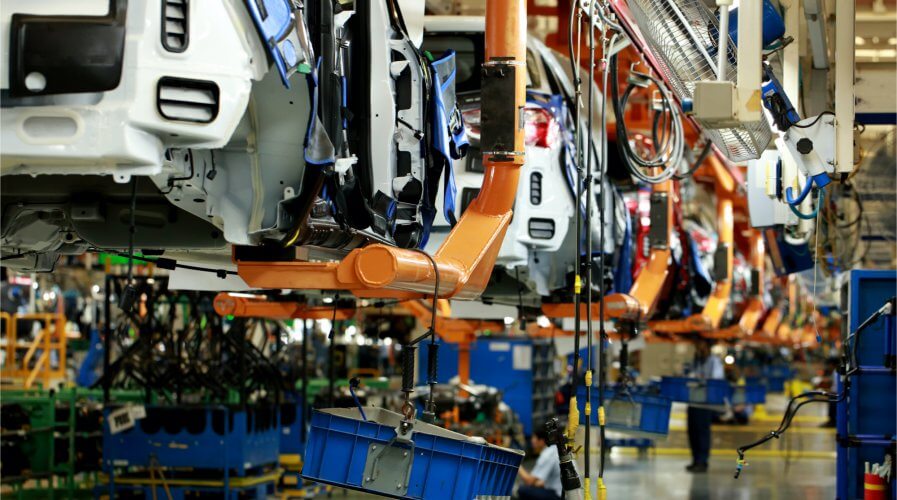
5G in manufacturing will be big business. Source: Shutterstock
5G is core to the smart factories of tomorrow – but there are risks
- The new era of smart manufacturing will be driven by 5G and IoT
- It will enable remote operations, advanced robotics, and minimize downtime
- But all these connected devices will also widen the cyberattack surface
Enterprise uptake will be the most lucrative sector for the 5G market. But as the cellular networking technology promises to be a milestone for the digitization of industries, it is manufacturing, in particular, that promises to be the biggest prize.
Here, 5G will be worth US4.6 trillion, according to Omdia’s ICT Enterprise Insights 2019/20 survey, accounting for the biggest chunk (5.4 percent) of the enterprise 5G market.
Manufacturing companies today are under extreme pressures and intense volatility due to ever-shortening business and product life cycles. As components become increasingly more varied and complex to produce, margins are tightening more than ever.
Worforces, meanwhile, are aging, while the COVID-19 disruption has highlighted the dangers of being over reliant on human labor. In a hyper-competitive landscape, manufacturers are eager to invest in technology that drives efficiency and productivity.
Tech Wire Asia recently interviewed Julian Gorman, the Head of Asia Pacific for GSMA, on why the fifth-gen mobile network is about to transform the manufacturing sector at a global scale.
Gorman shared that the major drivers of increased adoption of 5G in manufacturing are to spear mobility and flexibility in factories.
In this case, the confluence of ‘smart’ technologies, including automation, Internet of Things (IoT), big data analytics, and robotics in factory floors reshape once fixed and wired manufacturing systems that present little room for innovation or transformation.
In contrast, ‘smart manufacturing’ allows companies to adapt and evolve at an unprecedented speed — a characteristic highly prized in a constantly digitizing world.
“What’s happening in the last few months, we see manufacturers who have been building all sorts of things started to make masks, almost overnight, and that requires significant flexibility in the production line,” Gorman shared.
Therefore, Gorman stated “the demand for a flexible and dynamic manufacturing facility with cost controls and efficiencies built-in is rocketing to be globally competitive.”
On top of that, the ability to digitize the entire supply chain and bringing together production lines and delivery routes in a single system is a significant efficiency step in control.
“5G is the technology with low latency, the ability for lots of connections, high bandwidth, and network slicing. All these components contribute to being able to have a dynamic manufacturing floor.
“So that’s what we’re seeing drive the interest from manufacturers,” Gorman said.
Manufacturers that leverage on 5G will be rewarded with mobility and flexibility in deployment.
The ‘deployment’ in this context can be referred to as the building of a completely new establishment or a reconfiguration to the production line, such as the multitude of manufacturers that shifted to producing masks in the recent months.
Gorman explained 5G would significantly reduce the complexity of the flexibility in manufacturing as manufacturers “don’t have to worry about wiring up connectivity and to have everything being monitored in real time.”
5G in manufacturing will mean that, in the years to come, facilities won’t even have to be staffed. Facilities could be managed in disparate locations thanks to super-low latency connectivity.
“How we interact with machines, how we interact with us, between people, and between control points is going to change over the next couple of years,” Gorman said.
Machine & human interaction will change with 5G
Much like how many conscious organizations across a variety of industries swiftly responded to the wider health impact of COVID-19, by beginning to produce masks, PPE and ventilators to help meet shortages in healthcare facilities, for example, 5G will better enable manufacturers to swiftly change their operations and output when required.
This agility can potentially save manufacturers hundreds of thousands of dollars. The GSMA’s 5G for Smart Manufacturing Report, for example, highlighted a bespoke machinery manufacturer which commissions equipment on-site.
With a global customer base, the commissioning of equipment on-site and on-time poses a challenge. The manufacturer shared “in a recently commissioned plant the liquidated damages for not getting the commission completed by the handover date was US$400,000 per day.”
In addition, ensuring the necessary expertise on-site is another critical component and a challenge to address. Therefore, 5G, as a key technology in connectivity, presents some game-changing applications.
That same manufacturer is currently employing tools to establish remote video and sound access at the customer facility. By doing so, the manufacturer can connect their core expertise teams with less experienced in-the-field service workers to complete the deployment of machines.
5G plays a significant role in ensuring high-quality videos are streamed in low latency and immersive technology such as VR (virtual reality) and AR (augmented reality) will be a natural upgrade.
But with the advancements of 5G, pushed by a worldwide drive to Industrial 4.0 initiatives, the risk of cybersecurity remains prevalent across industries that wish to employ it.
While 5G is more secure than all previous generations and “it is inherently mobile operators’ DNA to secure their network,” Gorman said, “With the expectation of about 25 billion IoT devices on networks by 2025 […] a simple mathematical thing is — the more devices the more attack services are available for cyberattacks.”
It is therefore critical “that regulatory frameworks and manufacturers of devices are also brought into this collectively to make sure that security is managed as a total ecosystem.
“It’s not enough that mobile operators secure the 5G network, manufacturers of devices, regulators, need to make sure that they are also playing their part in securing the ecosystem that we’re developing,” Gorman said.
In the end, the role of 5G in driving smart manufacturing is promising and its applications have been documented.
The concept of ‘mobility’ and ‘flexibility’ illuminated by 5G resonates with the current climate of uncertainty and constant changes in manufacturing, hence, proving 5G to be an invaluable technology to bolster the evolving needs of manufacturing today and tomorrow.
READ MORE
- The criticality of endpoint management in cybersecurity and operations
- Ethical AI: The renewed importance of safeguarding data and customer privacy in Generative AI applications
- How Japan balances AI-driven opportunities with cybersecurity needs
- Deploying SASE: Benchmarking your approach
- Insurance everywhere all at once: the digital transformation of the APAC insurance industry


